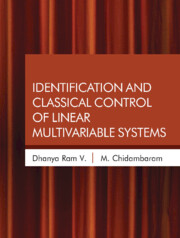Book contents
- Frontmatter
- Contents
- Preface
- Acknowledgements
- List of Abbreviations
- Notations
- 1 Models, Control Theory, and Examples
- 2 Identification and Control of SISO Systems
- 3 Introduction to Linear Multivariable Systems
- 4 CRC Method for Identifying TITO Systems
- 5 CRC Method for Identifying SISO Systems by CSOPTD Models
- 6 CRC Method for Identifying TITO Systems by CSOPTD Models
- 7 Identification of StableMIMO System by Optimization Method
- 8 Identification of Centralized ControlledMultivariable Systems
- 9 Identification of Multivariable SOPTD Models by Optimization Method
- 10 Identification of Unstable TITO Systems by Optimization Technique
- 11 Centralized PI Controllers Based on Steady State Gain Matrix
- 12 SSGM Identification and Control of Unstable Multivariable Systems
- 13 Control of Stable Non-square MIMO Systems
- 14 Control of Unstable Non-square Systems
- 15 Trends in Control ofMultivariable Systems
- Appendix A Identification of Unstable Second Order Transfer Function Model with a Zero by Optimization Method
- Appendix B For Chapter 3
- Appendix C For Chapter 7
- Bibliography
- Index
3 - Introduction to Linear Multivariable Systems
Published online by Cambridge University Press: 31 July 2022
- Frontmatter
- Contents
- Preface
- Acknowledgements
- List of Abbreviations
- Notations
- 1 Models, Control Theory, and Examples
- 2 Identification and Control of SISO Systems
- 3 Introduction to Linear Multivariable Systems
- 4 CRC Method for Identifying TITO Systems
- 5 CRC Method for Identifying SISO Systems by CSOPTD Models
- 6 CRC Method for Identifying TITO Systems by CSOPTD Models
- 7 Identification of StableMIMO System by Optimization Method
- 8 Identification of Centralized ControlledMultivariable Systems
- 9 Identification of Multivariable SOPTD Models by Optimization Method
- 10 Identification of Unstable TITO Systems by Optimization Technique
- 11 Centralized PI Controllers Based on Steady State Gain Matrix
- 12 SSGM Identification and Control of Unstable Multivariable Systems
- 13 Control of Stable Non-square MIMO Systems
- 14 Control of Unstable Non-square Systems
- 15 Trends in Control ofMultivariable Systems
- Appendix A Identification of Unstable Second Order Transfer Function Model with a Zero by Optimization Method
- Appendix B For Chapter 3
- Appendix C For Chapter 7
- Bibliography
- Index
Summary
In this chapter, interactions in multivariable systems, interaction measure, and suitable variables pairing are described. The design methods of decentralized controllers using a detuning factor to reduce the interactions are discussed. The methods of designing decouplers followed by the methods of designing single loop controllers are also discussed. The use of relay tuning to design decentralized Proportional and Integral (PI) controllers is brought out. The methods of designing simple centralized PI controllers are reviewed. The performance and robust stability analysis of the closed loop system are discussed.–
Stable Square Systems
Consider Fig. 3.1, where the connection of inputs and outputs are shown for TITO multivariable systems. For the step change in u1, record the change in y1 (as y1 versus t); this is called response and the change on y2 is called interaction of u1 on y2. Similarly, for the step change in u2, the change in y2 is called the response and that on y1 is called interaction. The control of output y1 by changing u1 and control of output y2 by u2 by the two controllers as shown in Fig. 3.2 is called decentralized control system. Here we have Eq. (3.1). For n input and n output systems, there are n controllers for a decentralized control system. If the interactions are significant, then the centralized control system is required as shown in Fig. 3.3.
Here, [u1 u2] = GcE
Where,
is a full matrix. And the error vector is defined the same as earlier. For n input and n output systems, there are n×n controllerswhich are to be used for the centralized control system.
Decentralized control system is popular in industries due to the following reasons:
(1) Decentralized controllers are easy to implement.
(2) They are easy for the operator to understand.
(3) The operator can easily retune the controllers to take into account changing process conditions.
(4) Tolerance for failures in measuring devices or in the final control elements is more easily incorporated into the design of decentralized controllers.
(5) The operator can easily bring the control system into service during process start up and can take it gradually out of service during shutdown.
- Type
- Chapter
- Information
- Publisher: Cambridge University PressPrint publication year: 2023

